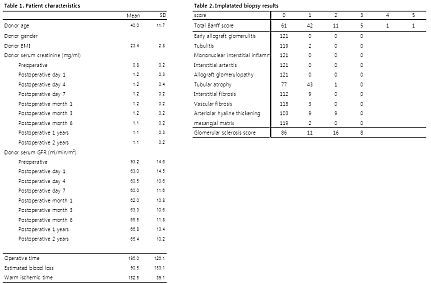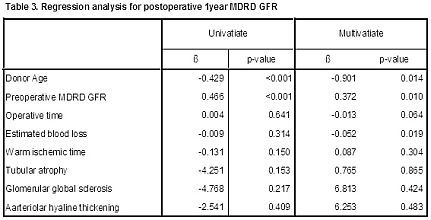Does the Abnormal Result of Implantation Renal Biopsy Affect the Donor Renal Function?
Urology, Yonsei University Health System, Urological Science Institute, Seoul, Republic of Korea
Surgery, The Research Institute for Transplantation, Yonsei University College of Medicine, Seoul, Republic of Korea
Meeting: 2013 American Transplant Congress
Abstract number: C1235
Introduction and Objectives. In this study, we focused on histological abnormalities which found in living kidney donor implantation biopsy (IB) and analyzed with renal function of remnant kidney. Methods. 121 living kidney donors who underwent IB between 2012 and 2011 were analyzed according to the Banff classification. Donor characteristics, intraoperative factors and perioperative renal functions were evaluated. (Figure 1) Results. Among the configuration parameters of Banff histological abnormality classification, tubular atrophy (ct), glomerular global sclerosis (gs) and arteriolar hyaline thickening (ah) were available for statistical analysis.

In preoperative factors, univariate and multivariate analysis revealed that only donor age are related with ct (OR=1.104, p=0.012) and gs (OR=1.050, p=0.019). Intraoperative factors – operative time estimated blood loss and warm ischemic time – were not related with any histological parameter. During the follow up period (up to postoperative 2 years), serial change of GFR level was not affected by histological abnormalities (ct, gs, ah or Banff score, p>0.05 each). Also these did not affect the renal function at the postoperative 1 year. On the other hand, donor age, preoperative GFR and estimated blood loss were the significantly related with GFR at postoperative 1 year.

Conclusions. Histological abnormalities in healthy living donors were mainly Banff score 1, slight changes. The occurrence of abnormalities was correlated with donor age. However, follow up renal function of living donor was not affected by these histological abnormalities.
To cite this abstract in AMA style:
Han W, Yang S, Joo D, Huh K, Kim M, Kim Y, Kim S, Choi K. Does the Abnormal Result of Implantation Renal Biopsy Affect the Donor Renal Function? [abstract]. Am J Transplant. 2013; 13 (suppl 5). https://atcmeetingabstracts.com/abstract/does-the-abnormal-result-of-implantation-renal-biopsy-affect-the-donor-renal-function/. Accessed December 15, 2025.« Back to 2013 American Transplant Congress
